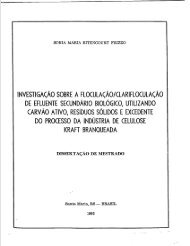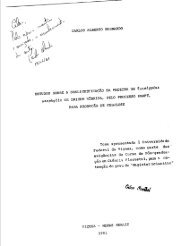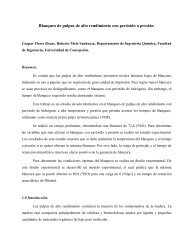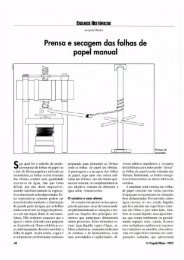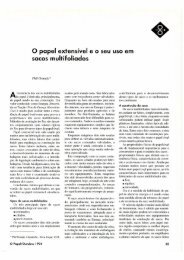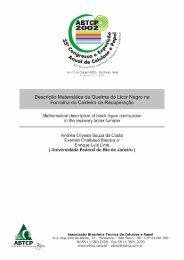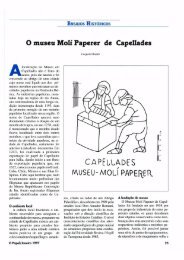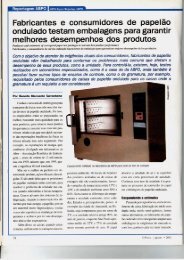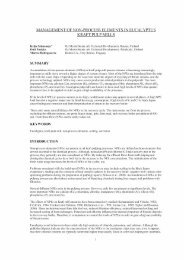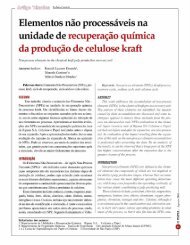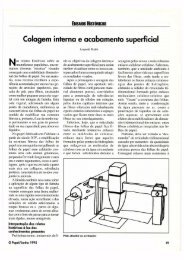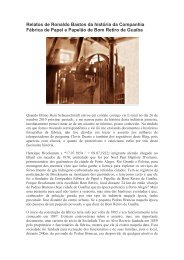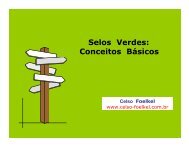O Eucalipto: um século no Brasil (The Eucalypt - Celso Foelkel
O Eucalipto: um século no Brasil (The Eucalypt - Celso Foelkel
O Eucalipto: um século no Brasil (The Eucalypt - Celso Foelkel
Create successful ePaper yourself
Turn your PDF publications into a flip-book with our unique Google optimized e-Paper software.
Os engenheiros do Instituto de Pesquisas Tec<strong>no</strong>lógicas repetem como <strong>um</strong> bordão<br />
que: “para seqüestrar o carbo<strong>no</strong> que aquece a atmosfera, o melhor é armazenálo<br />
em bens duráveis”. Para implementar essa idéia, dezenas de pesquisadores<br />
investiram a<strong>no</strong>s desenvolvendo tec<strong>no</strong>logias para secar o eucalipto, para serrá-lo sem que<br />
a madeira rachasse, para montar painéis de sarrafos de eucalipto, até que, n<strong>um</strong> convênio<br />
com a Faculdade de Belas Artes, foram criados os primeiros móveis de madeira de eucalipto,<br />
que agora começam a ser produzidos em larga escala.<br />
O pensamento se explica: para crescer, o eucalipto absorve água e, em presença<br />
da clorofila, retira o gás carbônico (CO 2 ) do ar, isto é, <strong>um</strong> dos gases que provocam o efeito<br />
estufa (aquecimento global), e ironicamente libera oxigênio. Ora, se o eucalipto é queimado<br />
como lenha, o CO 2 é liberado de <strong>no</strong>vo na atmosfera, mas se armazenado n<strong>um</strong> bem<br />
durável, como piso, móvel, porta, batente, poste ou mourão, o carbo<strong>no</strong> ficará “preso” na<br />
madeira por muito tempo.<br />
Outra linha tec<strong>no</strong>lógica, desenvolvida pelas indústrias, levou à produção do<br />
“Particleboard”, o antigo aglomerado, “Hardboard”, as chapas de fibra tradicionais e placas<br />
de “Medi<strong>um</strong> Density Fiberboard”, o MDF e “High Density Fiberboard”, o HDF, que levam<br />
ao uso de matéria-prima fornecida pelo eucalipto para a confecção de pisos, de móveis<br />
principalmente de cozinha, e até de ins<strong>um</strong>os para a indústria automobilística.<br />
As indústrias instaladas inicialmente para produzir chapas de fibra desenvolveram<br />
<strong>um</strong>a tec<strong>no</strong>logia relativamente simples e que não mudou muito. Há 50 a<strong>no</strong>s, como<br />
ainda hoje, as indústrias cortam o eucalipto, picam a madeira transformando-a em cavacos<br />
<strong>um</strong> pouco maiores ou <strong>um</strong> pouco me<strong>no</strong>res e mecanicamente fazem o desfibramento dessa<br />
matéria-prima, chegando a <strong>um</strong>a massa de fibras que, transformadas em mantas, são<br />
prensadas a altas temperaturas. A própria lignina do eucalipto provoca a aglutinação, o que<br />
elimina a necessidade de cola e o resultado é a chapa dura de fibra.<br />
Para a produção do MDF e HDF, a massa de fibras recebe resina fenólica para a adesão e é<br />
prensada a altas temperaturas. Na realidade é a recriação da mesma madeira da árvore, só<br />
que n<strong>um</strong> formato pla<strong>no</strong>, em vez do cilíndrico, como ela se apresenta na natureza. Nestes<br />
produtos o carbo<strong>no</strong> permanece seqüestrado.<br />
O E U C A L I P T O - U M S É C U L O N O B R A S I L<br />
104<br />
Instituto de Pesquisas Tec<strong>no</strong>lógicas, IPT’s engineers repeat the phrase that “to<br />
sequester the carbon that is heating the atmosphere up, it is best to store it in<br />
durable goods.” To implement this idea, dozens of researchers invested years<br />
developing tech<strong>no</strong>logies to dry eucalypt to saw it without cracking the wood, to<br />
assemble eucalypt slats, until in a partnership with the Faculdade de Belas Artes, the<br />
first furniture made out of eucalypt wood was made, pieces which are <strong>no</strong>w starting<br />
being produced on the large scale.<br />
<strong>The</strong> idea can be explained: to grow, eucalypt absorbs water and, in the presence of<br />
chlorophyll, it removes carbon dioxide (CO 2 ) from the air, i.e., one of the gases that<br />
cause the greenhouse effect (global warming), and, ironically, releases oxygen. Well,<br />
if eucalypt is burnt as firewood, CO 2 is released back to the atmosphere, but if it is<br />
stored in a durable good, such as flooring, furniture, in a door or doorpost, in a post<br />
or fencepost, the carbon will be “retained” in the wood for a long time.<br />
A<strong>no</strong>ther tech<strong>no</strong>logical line the industries developed led to the production of the<br />
“Particleboard,” the old agglomerate, “Hardboard,” the traditional fiber plates and<br />
“Medi<strong>um</strong> Density Fiberboard” plates, MDF, and “High Density Fiberboard,” HDF,<br />
that use the raw material provided by eucalypt to manufacture flooring, furniture<br />
(especially for the kitchen), and even input for the auto industry.<br />
<strong>The</strong> plants installed initially to produce fiber plates developed a relatively simple<br />
tech<strong>no</strong>logy that hasn’t changed much. Fifty years ago, as today, the plants cut the<br />
eucalypt, chop the wood up turning it into splinters that vary in size and, mechanically,<br />
remove the fiber from this raw material, resulting in a mass of fibers<br />
which, turned into blankets, are pressed at high temperatures. <strong>Eucalypt</strong>s lignin<br />
itself causes the agglutination, eliminating the need to use glue and resulting in a<br />
hard fiber plate.<br />
To produce MDF and HDF, the fiber mass receives phe<strong>no</strong>lic resin for adhesion and<br />
it is pressed at high temperatures. <strong>The</strong> outcome is the recreation of the of the tree’s<br />
wood, <strong>no</strong>w in a flat, <strong>no</strong>t a cylindrical shape, as in nature. Carbon remains sequestered<br />
in these products.




